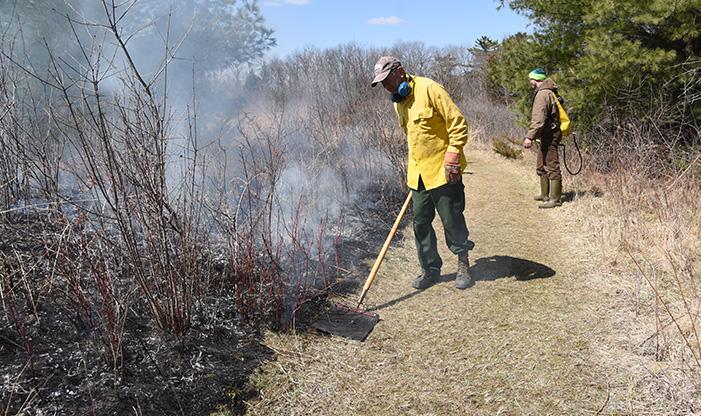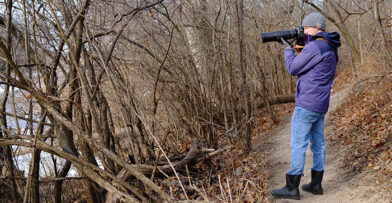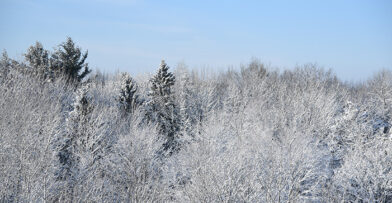Prescribed burns are a useful and effective tool for land managers to maintain prairie habitats. Burns benefit the land in different ways depending on when they are conducted. Spring burns curtail the growth of several species of undesirable plants, which ultimately helps overall prairie health, while fall burns promote wildflowers.
Controlled burning of prairies has a far-reaching historical precedent. Native Americans conducted burns to maintain prairie habitat so bison herds would flourish. The fires mimicked the effects of lightning strikes and kept the prairies healthy, while creating the conditions needed for good hunting land.
Schlitz Audubon plans to conduct prescribed burns in several of our prairie habitats in early spring of 2023 if conditions are favorable. Ideally, prescribed burns are done in the same area every two to five years. Holding to this frequency is considered optimal to reap the longer-term rewards of burning and to keep certain plant growth at bay.
The Science Behind Prescribed Burns
There is a science behind prescribed burns that forms the basis for creating a flourishing habitat. First, a prescribed burn removes the duff layer, which consists of old plant detritus, opening space in the ground layer for new, desirable plants. After the spring thaw, the grasses are matted down and burn more thoroughly, killing the grasses underneath. An early spring burn (before the growth of warm season grasses) will stop cool season grasses, controlling non-native Eurasian plant species, as well as prevent woody stemmed plants from growing.
A burn creates blackened soil, whose dark color absorbs and holds onto sunlight more readily than unburned soil, increasing its temperature. The warmth stimulates the growth of warm season grasses, including big bluestem and Indian grass, which will grow prolifically after a burn.
Prevention of woody growth, including dogwoods, ash trees, and buckthorn, is a key factor in managing prairies. Burns remove woody plants, preventing the land from turning into a forest habitat. Not all trees are killed during a burn, however. Species like oaks have adapted thick bark, which shields them from the flames. Only large oaks, however, have bark thick enough; young ones need to be protected by land managers.
Preparing for a Burn
Great care is taken to prepare for a prescribed burn. Safety is the number one priority! Each season, one of the first steps the Center’s land management team undertakes is creating a burn map. This shows all areas to be burned, as well as the placement of firebreaks, which are areas of ground where nothing is flammable. At Schlitz Audubon, we also consider the presence of visitors and students, so they remain safe.
Weather Conditions for a Prescribed Burn
The Center’s land management team will begin to watch wind speed and direction, temperature, and humidity leading up to the day scheduled for a burn, and especially on the day of the burn. Drew Shuster, Director of Conservation, said a desirable and safe wind speed is 5-15 mph. The slow speed helps prevent the appearance of unpredictable fire, which can get away from the planned burning locations. The optimal temperature is 40-60 degrees; above 80 degrees it’s considered hazardous, while at temperatures below 32 degrees, the fire won’t burn.
Humidity is an important factor in determining the effectiveness and safety of a potential burn. Relative humidity determines how hot a fire will burn on prairie grasses. Drew likes to conduct a burn at 20-60 percent humidity. Above 60 percent, the fire burns poorly, and below 20 percent, fire is considered hazardous. Compared to other areas in our region, the air near Lake Michigan is more moist due to the lake effect, so this also needs to be taken into consideration.
The burn crew gauges wind direction. In an urban or suburban setting, such as Schlitz Audubon, controlling the direction of smoke is of great importance. The wind affects the smoke’s movement and the effectiveness of the burn breaks. A change in wind direction can present challenges by causing the fire to become unpredictable.
The Burn Crew
Only people experienced with prescribed burning should participate. At the Center, there are a number of staff and volunteers involved. Some, such as the burn boss, focus on overseeing the entire process, while the line crew will focus on setting or tending the fire. There are also people who watch the fire to make sure it doesn’t jump to an unplanned spot.
To keep the fire under control, the line crew uses backpack sprayers to shoot a focused stream of water where it is needed. The water prevents the fire from spreading in directions other than where it is needed to go. They also use fire swatters and flappers to control the direction and growth of the flames.
The Process of Conducting a Prescribed Burn
There are some naturally occurring firebreaks, which include a road, a body of water, or a trail. If they are not present naturally, firebreaks are created. This may be done by mowing an area of the prairie to remove material such as drier grasses. It is also accomplished by burning an area of land to remove the flammable material. It is important to create these non-flammable areas, so fire doesn’t spread beyond its desired location.
A typical burn will have firebreaks on three sides, creating a U shape. The main portion of the burn is done within a U shape, using a stepladder formation to coordinate the flames, called head fires. Once the U is formed, the crew begins by lighting a fire on a small strip across the U, creating one step of the ladder. The wind pushes the fire forward, down the U, into the break at the bottom. Then, once the first strip area of the step has burned, they move up the U to do the next strip. Each step is burned in succession until the entire area within the U shape is complete. This method keeps the fire under control.
What Visitors Will Notice
This year, our land management team and their volunteers will use prescribed burns in the West Meadows, on the Terrace’s prairie, and in an area south of Molly’s Pond. About a week afterward, visitors will notice green shoots rising through the “black,” a term describing the area where all the soil is blackened from the burn. People will also see vigorous bird activity in this area, as insects become abundant.
Then, after a couple of weeks the warm season grasses will begin to grow, and ultimately, they will be almost two feet taller than they would be without the burn. The enhanced growth will last from 1-2 years, and visitors will see the difference when the burned areas are in proximity to unburned areas and can compare the heights of the grasses. After this period the grasses will resume growing to their shorter, more commonly seen height.
At the Center, it’s necessary to use prescribed burns to prevent the prairie from returning to forest. Our prairies are prime locations for wildlife, education, and people’s enjoyment. Maintaining the prairie is important to continue providing such good habitat for prairie wildflowers, insects, and the animals that dwell on prairie lands. Visit the Center later this spring to witness the effects of this wonderful conservation activity in person.
Written with contributions from Drew Shuster


